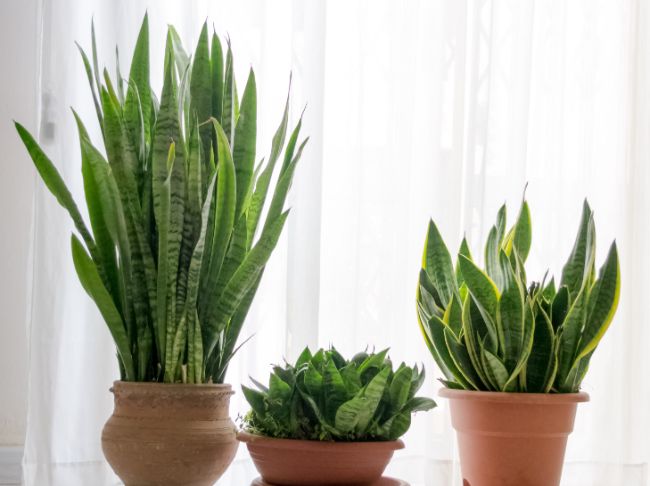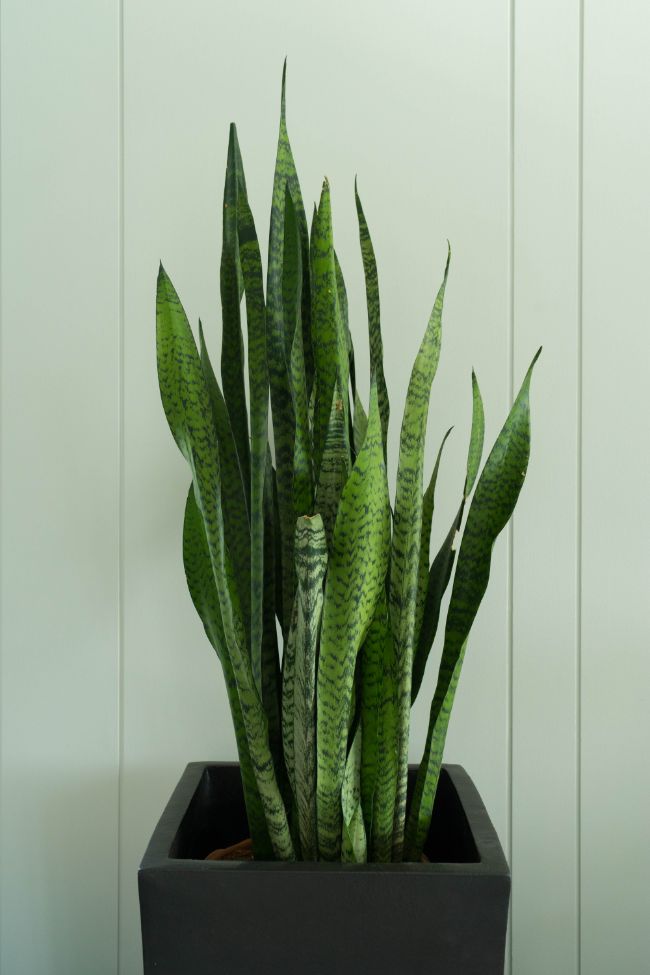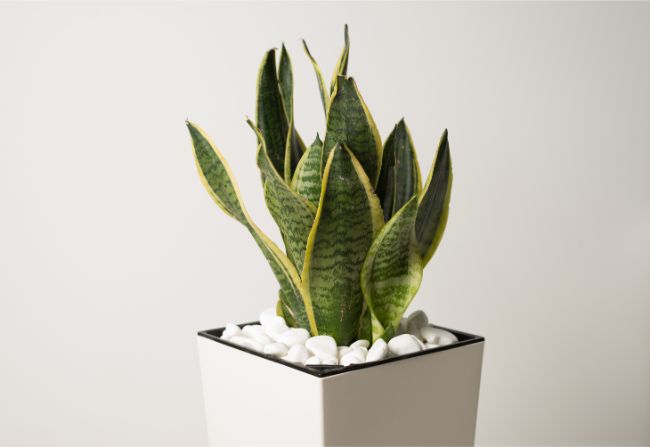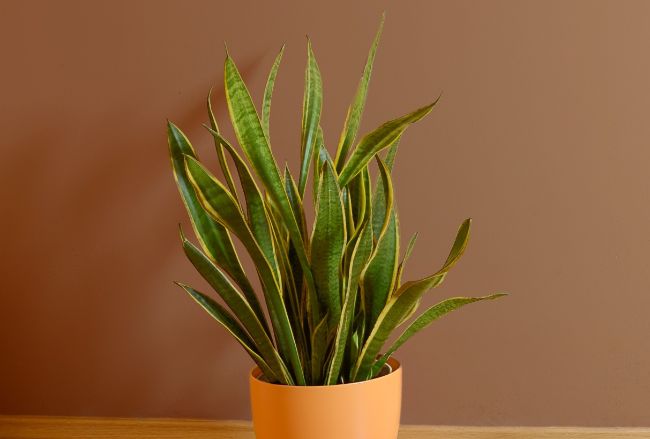If you find your snake plant leaves curling and want to fix the problem, identifying the cause is the first step. Looking for key signs of plant stress and determining the underlying issue will help you know how to tackle the problem.
Why do snake plant leaves curl? The most likely cause of leaves curling on a snake plant is an insect infestation. Overwatering, cold stress and fungal infections are also key reasons why you might see curling leaves.
Determining which of these issues is the underlying cause of snake plant leaves curling isn’t too hard, but is essential if you want to fix the problem and get your plant back to a healthy state. Read on to find out why your snake plant has curled leaves and how to fix each problem with ease.
Causes and Solutions
The four main causes of curling leaves are insects, fungus, cold damage and improper watering. Because snake plants are particularly susceptible to pests like thrips, this is one of the most common causes of plant leaves curling.
Snake Plant Leaves Curling Due To Insects And Pests

Thrips
The most common affliction for snake plants is a thrip infestation. These tiny black bugs favor the entire plant, including leaves, buds and stems. When thrips feed, they penetrate the cell wall and damage the plant. This damage can cause your snake plant leaves to curl.
The way thrips feed can help you identify them. A snake plant infested with thrips will appear to have tiny black specks on plant leaves and buds. If you think you have thrips, try to identify these black spots. If needed, you can use a magnifying glass to confirm that the pest is thrips.
Another way to identify thrips is by shaking the leaves of your plant over a sheet of white paper. If you see tiny black bugs, you might have a thrip infestation.
After identifying this pest, you can start to solve the problem. To treat your snake plant infected with thrips, remove all infected leaves. This requires removing dead and dying leaves with a sharp kitchen knife.
If the leaves are curling but still look reasonably healthy, keep them. After removing dead leaves, ensure to discard them far away from any other plant life. Then, use a wet cotton ball or cloth to wipe down your snake plant leaves. Ensure that you wipe both sides of each leaf to remove all bugs from the plant.
If the thrip infestation has begun to kill the majority of your plant, ensure that you dispose of the entire plant properly. Cross-contamination between your plants can cause one plant infestation to spread rapidly. Because the snake plant is durable, seeing curling leaves in response to a thrip infestation will generally mean that the plant can be saved.
Mealybugs And Spider Mites
The snake plant is prone to mealybugs and spider mite infestations as well. These pests will feed on the sap of the snake plant through the stem. The small wounds produced by these pests will cause the plant to become weak and be unable to store an adequate amounts of water in the leaves. At more advanced stages of infestation, you will see leaves falling off.
Spider mites can be identified by putting a white piece of paper underneath a plant and shaking. If you see small, rotund red and black mites, you’ll know the cause of the stress in your snake plant.
A quick and effective remedy for spider mites is to wipe the bottom of the leaves with room-temperature water. This targets the most popular hiding space of spider mites. You can use a damp sponge and take special care with the entire plant. If you prefer a faster remedy, you can also spray the plant with a hose outside. A heavily infested plant might take multiple applications to take care of the issue.
Mealybugs are a common affliction that causes stress to snake plants as well. These can be identified by their appearance, with flat and waxy soft bodies. They are oval in shape and have segmented bodies, a characteristic of grubs. In an advanced case of infestation, you can identify mealy bugs by the white cotton-textured eggs.
If you’ve identified mealybugs as your issue, you can proceed to try to pick them off by hand. This is a good remedy for a small, localized infestation. If you have a larger issue, the mealybugs can be dislodged from their hold on the plant underneath a water bath outside.
If your spider mite or mealybug infestation requires a chemical treatment, an insecticidal soap is a widely-available remedy. Insecticides assist the plant in recovery by penetrating the exterior of the bugs and causing an imbalance in electrolyte levels. Spider mites and mealybugs will find the plant inhospitable.
A good alternative remedy to insecticide spray is a soap mixture. Combining a dish liquid with water and spraying the plants indoors is an effective way to decrease a bug infestation. Soapy water suffocates the bugs and kills both adults and eggs.
I’ve written an article all about how to get rid of houseplant bugs naturally. It’s full of helpful information to help you get rid of all kinds of insect infestations using natural remedies that really work.
Fungus Is A Cause Of Snake Plant Leaves Curling
The snake plant can experience fungal problems that cause the leaves to curl. Southern blight and red leaf spot are common issues that affect the snake plant.
To recognize this as the issue, look for signs of plant stress in addition to curling leaves. The red leaf spot can often cause leaves to display red lesions or a white web-like growth. In later stages of this fungal infection, the curling leaves turn dark brown and harden.
To alleviate a fungal problem, ensure to follow proper watering techniques. Maintaining an environment where the leaves are dry and providing well-drained soil in ideal temperatures can help alleviate the issue.
If the fungal issue is too severe and you want to dispose of the plant, ensure this is done in a place far away from other plant life. If you want to save the plant but it has a very bad fungal infection, consider propagation or repotting the plant. You are able to save a small part of the plant while disposing of the most severely infected portions.
When repotting a snake plant, it is important to consider container size and soil conditions. The snake plant should be repotted to be positioned at the same depth it was previously growing. The root ball should sit one to two inches below the pot rim, for efficient water absorption.
After you place the snake plant in a new pot, make sure to add or remove enough soil so that the root ball is at the proper depth. The soil should be well-draining and provide adequate nutrients for the snake plant. Consider a soil with fertilizer if you want to ensure the best environment for the plant.
If you think fungus is the cause of your problem and want to get rid of your infected plant, you can still save a piece of the snake plant through propagation. Propagating snake plants is easy because they are fast to put down roots.
First, choose a leaf that is not infected by fungus. Make sure to wipe the leaf down before placing it in another pot, to prevent cross-contamination. After a wipe down, cut a three inch section of leaf and place it in moist potting soil. The soil should be kept evenly moist for the next few weeks until you see growth.
After propagation, you may find that your snake plant is doing better than ever! The variegated foliage of this plant means that it will continue growing through many conditions, and may require thinning in the most habitable environments.

Snake Plant Leaves Curling Due To Watering Issues
Snake plants often suffer from overwatering, which can produce curling leaves. Overwatering the snake plant can cause roots to become water-logged. Water-logged roots can rot and kill the plant.
When looking to identify this issue, reflect on your watering schedule and soil content. If you water your snake plant more than once every few days, you are probably causing water-logged roots and leaf curling. If your soil is dense and clay-based, then you might be causing the same issue.
To remedy snake plant leaves curling because of water stress, make sure you are watering your plants on a consistent schedule. Snake plants only need water once their potting soil is almost fully dry.
Irregular watering can be an issue that can cause further stress to your snake plant. Changing the soil can also be a good remedy. Make sure your soil is comprised of a well-drained, sandy soil. Cactus mix works well for making a good habitat for snake plants.
If you want to become a pro at watering houseplants, read my articles about how to tell when a houseplant needs water and how often to water houseplants.
Snake Plant Leaves Curling Due To Cold Damage
Cold damage can be a cause of snake plant leaves curling. If you leave your snake plant outside in low temperatures, you can cause damage to the leaves that results in scarring, wilting and curling.
The best temperature for snake plants is between 50-85 °F. This wide temperature range makes it easy to provide the right temperature. Just watch out for low temperatures for those plants that are kept outside for part or all of the year.
You may also be interested in reading my other content about snake plants.
Ultimate Care Tips For Snake Plants
One of the best ways to keep your snake plant from having curling leaves is to have a good care regimen that takes into account the plant’s various habitat requirements.
Treating plants with insecticides and repotting plants to prevent cross-contamination both cause plant stress. Plant stress often results in further issues with houseplants. Taking into consideration the optimal conditions, listed below, means you’ll create the strongest, most durable snake plant possible.
- Bright, indirect sunlight
- Well-drained sandy soil
- Water once the potting media is dry
- Humid environment
- Temperature 50 – 85 °F

What’s a quick and easy way to see if my snake plant is infested with thrips?
Placing a sticky fly paper near your snake plant will attract thrips quickly. This is one of the easiest ways to see if your snake plant leaves are curling because of a thrip infestation.
Will my snake plant recover from serious wilting?
Snake plants are resilient and thrive in a range of conditions. They are great at bouncing back from the brink of death, according to experienced gardeners. If your snake plant is struggling, definitely have a good go at trying to save the plant. Chances are, you’ll be able to revive it!

